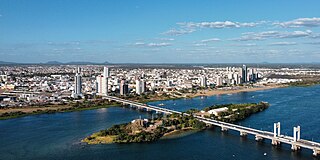
The economy of Guatemala is a considered a developing economy, highly dependent on agriculture, particularly on traditional crops such as coffee, sugar, and bananas. Guatemala's GDP per capita is roughly one-third of Brazil's. The Guatemalan economy is the largest in Central America. It grew 3.3 percent on average from 2015 to 2018. However, Guatemala remains one of the poorest countries in Latin America and the Caribbean, having highly unequal incomes and chronically malnourished children. The country is beset by political insecurity, and lacks skilled workers and infrastructure. It depends on remittances for nearly one-tenth of the GDP.
Purchasing power parity (PPP) is a measure of the price of specific goods in different countries and is used to compare the absolute purchasing power of the countries' currencies. PPP is effectively the ratio of the price of a basket of goods at one location divided by the price of the basket of goods at a different location. The PPP inflation and exchange rate may differ from the market exchange rate because of tariffs, and other transaction costs.

Petrolina is a municipality located in the southernmost point of the state of Pernambuco, in Northeast Brazil, in the valley of the São Francisco River. The population was 354,317 in 2020, and the total area is 4,756.8 km², making it the largest municipality in the state by area. The municipality is closely integrated with Juazeiro, Bahia, located on the opposite bank of the São Francisco.

Poverty in India remains a major challenge despite overall reductions in the last several decades as its economy grows. According to an International Monetary Fund paper, extreme poverty, defined by the World Bank as living on US$1.9 or less in purchasing power parity (PPP) terms, in India was as low as 0.8% in 2019, and the country managed to keep it at that level in 2020 despite the unprecedented COVID-19 outbreak. According to World Bank, extreme poverty has reduced by 12.3% between 2011 and 2019 from 22.5% in 2011 to 10.2% in 2019. A working paper of the bank said rural poverty declined from 26.3% in 2011 to 11.6% in 2019. The decline in urban areas was from 14.2% to 6.3% in the same period.The poverty level in rural and urban areas went down by 14.7 and 7.9 percentage points, respectively. According to United Nations Development Programme administrator Achim Steiner, India lifted 271 million people out of extreme poverty in a 10-year time period from 2005–2006 to 2015–2016. A 2020 study from the World Economic Forum found "Some 220 million Indians sustained on an expenditure level of less than Rs 32 / day—the poverty line for rural India—by the last headcount of the poor in India in 2013."

Bolsa Família is the current social welfare program of the Government of Brazil, part of the Fome Zero network of federal assistance programs. Bolsa Família provided financial aid to poor Brazilian families. In order to be eligible, families had to ensure that children attend school and get vaccinated. If they exceeded the total of permitted school absences, they were dropped from the program and their funds were suspended. The program attempted to both reduce short-term poverty by direct cash transfers and fight long-term poverty by increasing human capital among the poor through conditional cash transfers. It also worked to give free education to children who couldn't afford to go to school, to show the importance of education. In 2008, The Economist described Bolsa Família as an "anti-poverty scheme invented in Latin America [which] is winning converts worldwide." The program was a centerpiece of former president Luiz Inácio Lula da Silva's social policy and is reputed to have played a role in his victory in the general election of 2006. Bolsa Família was the largest conditional cash transfer program in the world, though the Mexican Oportunidades was the first nationwide program of this kind.
Poverty in South America is prevalent in most of its countries. Those that have the highest rates of poverty per population are Suriname, Bolivia and Venezuela. Recent political shifts in the region have led to improvements in some of these countries. In general, most South American economies have attempted to tackle poverty with stronger economic regulations, foreign direct investments and implementation of microeconomic policies to reduce poverty.
Bangladesh is an under-devoloped nation. Despite rapid economic growth, poverty remains a major issue. However, poverty has declined sharply in recent history. Shortly after its independence, approximately 90% of the population lived under the poverty line. However, since economic reforms and trade liberalization of early 1990s, along with accelerated economic growth since early-2000s, Bangladesh have experienced a dramatic progress in reducing poverty. The remarkable progress in poverty alleviation has been recognized by international institutions. According to World Bank, more than 33 million Bangladeshi people have been lifted out of poverty since 2000; as measured by the percentage of people living on the equivalent of US$1.90 or less per day in 2011 purchasing price parity terms.

Until the 1920s, most of the Vietnamese population lived under the poverty line. This was due to a number of reasons, which was a result from years as a French colony, the Japanese occupation of Vietnam, the Vietnam-American War, and further conflicts within Mainland Southeast Asia. Continuous conflicts from 1887 to 1991, more than 100 years of instability had left Vietnam a war-torn country that was prone severe floods from typhoons, rising sea levels, as well as the so-called "flood season" from seasonal monsoons, as well as the effects of climate change.
Turkey made steady progress in reducing poverty from the early 2000s to the mid-2010s.




